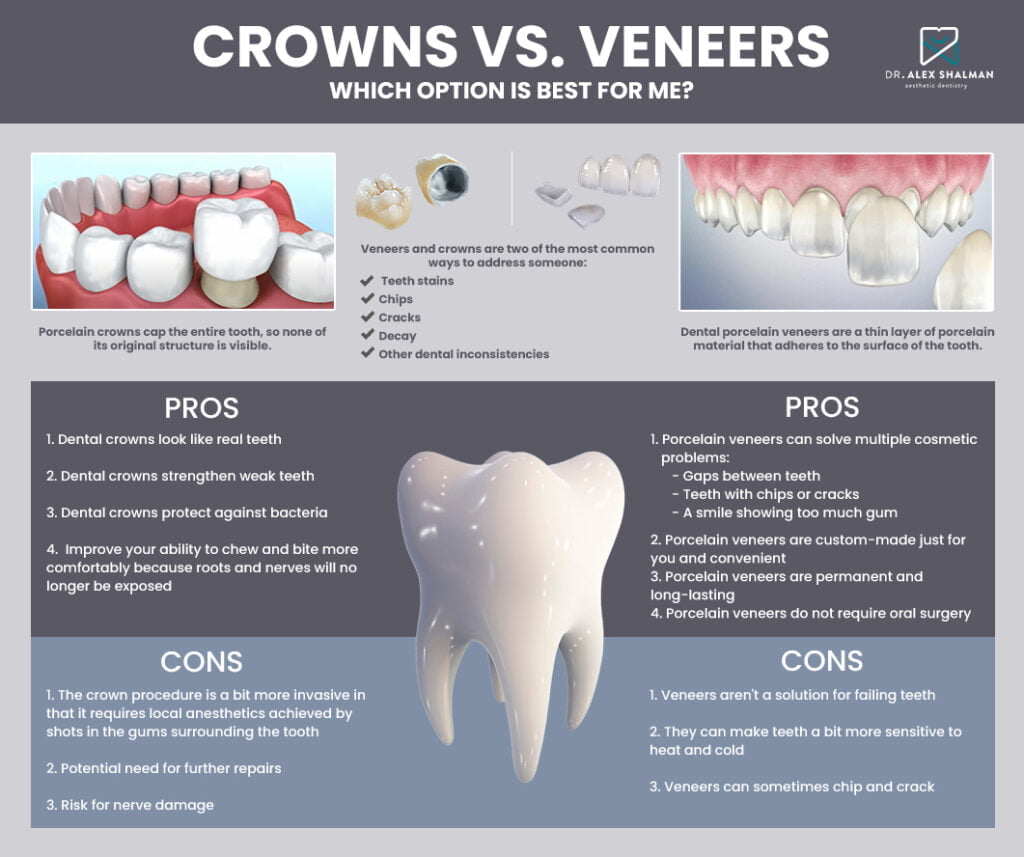
Table of contents

Porcelain crowns and veneers are two of the most popular dental treatments available. These innovative techniques can help improve the appearance of your smile, but both are used in very different situations. Although both use highly lifelike porcelain that closely replicates the appearance of natural teeth, it’s most likely that one procedure will be more suitable for your situation than the other. Understanding how each work can be useful; when you visit Dr. Shalman, your cosmetic dentist in Lower Manhattan for treatment, you will understand what he is explaining and can ask more pertinent questions about each procedure.
A porcelain veneer consists of a thin laminated shell of porcelain that is handcrafted to replace tooth enamel. It is fabricated to fit exactly over the outer surface of a front tooth that has been hand prepared by your cosmetic dentist, who will remove a minimal amount of tooth structure to create enough room for the veneer.
Because a veneer is typically 0.5 mm in thickness, your dentist Dr. Alex Shalman only needs to remove a tiny amount of tooth structure to ensure the veneer looks fantastic.
Porcelain veneers are typically used as a cosmetic procedure, often as part of the complete, full-mouth smile makeover. Veneers can enhance the appearance of natural teeth and can restore teeth that have minor imperfections in their appearance.
You might want to choose porcelain veneers if you have:
Porcelain veneers are used to disguise the appearance of front teeth that you show when you smile or talk with others. They can be fitted onto upper and lower teeth.
Veneers are excellent for hiding the appearance of teeth that are less than aesthetically appealing or which are too small or severely worn. They can also hide teeth that are slightly chipped or cracked. Some people use veneers instead of orthodontic treatment.
For example, if you have only one or two teeth that are out of alignment, you can use veneers to bring them back into line, creating a more cosmetically perfect appearance. Veneers are a quicker treatment compared with orthodontics that typically takes several months to complete.
Another reason for choosing veneers is if you have unsightly gaps between your teeth. Porcelain veneers can be fabricated to close these gaps or at least minimize them.
Initially, you will need to see your dentist for a full evaluation. For veneer treatment to be successful, your teeth need to be reasonably healthy and can’t have any big fillings or significant decay as otherwise, they could be too weak for dental veneers.
During your initial evaluation, your dentist can discuss this treatment more fully with you, and together you can decide how many veneers are necessary.
Once you have decided to go ahead with porcelain veneers treatment, your dentist will generally need to prepare your teeth.
Tooth preparation isn’t always necessary for porcelain veneers as some are what are called prep-free or prepless veneers.
These veneers are made from thinner porcelain that is incredibly strong and is fitted directly onto the tooth surface. While an excellent treatment, prepless veneers are only suitable in specific circumstances. For example, if you have protrusive teeth, these teeth must be reshaped as they cannot be brought back into line unless some tooth structure is removed.
So, how does treatment differ from porcelain crowns?
Porcelain crowns cap the entire tooth, so none of its original structure is visible.
Because the crown covers the whole tooth, substantial preparation is needed to remove enough structure to make room for the crown. Porcelain crowns can change the color and shape of the tooth, and the latest all-ceramic crowns look fantastic.
Porcelain crowns are used when a tooth is severely damaged. For example, if you have a tooth with:
These situations usually destroy a significant amount of the original tooth structure, and placing an ordinary filling wouldn’t be sufficient to restore strength and structure to the tooth.
Dental crowns can also be useful for people with significant bruxism where they have worn their teeth down by grinding and clenching, or for those who have suffered from significant enamel erosion.
Crowning a tooth restores the missing tooth structure and the tooth appearance, ensuring you can bite and can smile and talk confidently because your teeth will look great.
Both crowns and veneers should last for years before they need replacing. However, it’s important to look after them properly as this will prolong their life. Make sure you brush and floss around them thoroughly and see your dentist regularly for checkups and cleanings.
For more information about the porcelain crowns and veneers at Shalman Dentistry, visit our dental center in Lower Manhattan, schedule a dental appointment or call us: (212) 658-1093
Shalman Dentistry
44 W 10th St #1A
New York, NY 10011
(10th St, between 5th & 6th Avenue)
☎ (212) 658-1093
Get Directions (Map)